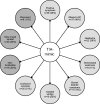How do neurologists diagnose transient ischemic attack: A systematic review
- PMID: 30507363
- PMCID: PMC6604401
- DOI: 10.1177/1747493018816430
How do neurologists diagnose transient ischemic attack: A systematic review
Abstract
Background: Identifying and treating patients with transient ischemic attack is an effective means of preventing stroke. However, making this diagnosis can be challenging, and over a third of patients referred to stroke prevention clinic are ultimately found to have alternate diagnoses.
Aims: We performed a systematic review to determine how neurologists diagnose transient ischemic attack.
Summary of review: A systematic literature search was performed according to the Preferred Reporting Items for Systematic Reviews and Meta-Analyses (PRISMA) guidelines using MEDLINE, Embase, and the Cochrane Library databases. Publications eligible for inclusion were those that included information on the demographic or clinical features neurologists use to diagnose transient ischemic attacks or transient ischemic attack-mimics. Of 1666 citations, 210 abstracts were selected for full-text screening and 80 publications were ultimately deemed eligible for inclusion. Neurologists were more likely to diagnose transient ischemic attack based on clinical features including negative symptoms or speech deficits. Patients with positive symptoms, altered level of consciousness, or the presence of nonfocal symptoms such as confusion or amnesia were more likely to be diagnosed with transient ischemic attack-mimic. Neurologists commonly include mode of onset (i.e. sudden versus gradual), recurrence of attacks, and localizability of symptoms to a distinct vascular territory in the diagnostic decision-making process. Transient ischemic attack diagnosis was more commonly associated with advanced age, preexisting hypertension, atrial fibrillation, and other vascular risk factors.
Conclusions: Neurologists rely on certain clinical and demographic features to distinguish transient ischemic attacks from mimics, which are not currently reflected in widely used risk scores. Clarifying how neurologists diagnose transient ischemic attack may help frontline clinicians to better select patients for referral to stroke prevention clinics.
Keywords: Transient ischemic attack; decision analysis; stroke; stroke mimic; stroke prevention.
Figures




References
-
- Johnston SC, Gress DR, Browner WS, Sidney S. Short-term prognosis after emergency department diagnosis of TIA. JAMA 2000; 284: 2901. - PubMed
-
- Rothwell PM, Giles MF, Chandratheva A, et al. Effect of urgent treatment of transient ischaemic attack and minor stroke on early recurrent stroke (EXPRESS study): a prospective population-based sequential comparison. Lancet 2007; 370: 1432–1442. - PubMed
-
- Hall R, Khan F, O'Callaghan C, et al. Ontario stroke evaluation report 2013: spotlight on secondary stroke prevention and care, Toronto: Institute for Clinical Evaluative Sciences, 2013.
-
- Coutts SB, Modi J, Patel SK, Demchuk AM, Goyal M, Hill MD. CT/CT angiography and MRI findings predict recurrent stroke after transient ischemic attack and minor stroke: results of the prospective CATCH study. Stroke 2012; 43: 1013–1017. - PubMed
Publication types
MeSH terms
LinkOut - more resources
Full Text Sources
Medical
Research Materials

